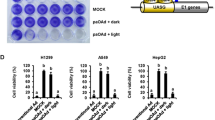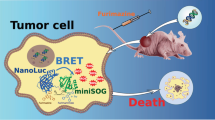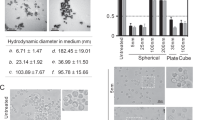Abstract
Tumor targeting is an important issue in cancer gene therapy. We have developed a gene transfection method, based on light-inducible photochemical internalization (PCI) of a transgene, to improve gene delivery and expression selectively in illuminated areas, for example, in tumors. In the present work, we demonstrate that PCI improved the nonviral vector polyethylenimine (PEI)-mediated transfection of a therapeutic gene, the ‘suicide’ gene encoding herpes simplex virus thymidine kinase (HSVtk). In U87MG glioblastoma cells in vitro, the photochemical treatment stimulated expression of the HSVtk transgene, and, consequently, enhanced cell killing by the subsequent treatment with the prodrug ganciclovir (GCV). When relatively low doses of DNA (1 μg/ml) and the PEI vector (N/P 4) were used, HSVtk gene transfection followed by the GCV treatment did not have an effect on cell survival unless the photochemical treatment was performed, which potentiated the cytotoxicity to 90%. These findings indicate that photochemical transfection allows: (i) selective enhancement in gene expression and gene-mediated biological effects (cell killing by the Hsvtk/GCV approach) in response to illumination; (ii) the use of low, suboptimal for the nonviral transfection methods without PCI, doses of both DNA and the vector, which may be relevant and advantageous for therapeutic gene transfer in vivo.
This is a preview of subscription content, access via your institution
Access options
Subscribe to this journal
Receive 12 print issues and online access
$259.00 per year
only $21.58 per issue
Buy this article
- Purchase on Springer Link
- Instant access to full article PDF
Prices may be subject to local taxes which are calculated during checkout






Similar content being viewed by others
References
Curiel DT . Strategies to adapt adenoviral vectors for targeted delivery. Ann NY Acad Sci. 1999;886:158–171.
Cristiano RJ . Targeted, non-viral gene delivery for cancer gene therapy. Front Biosci. 1998;3:D1161–D1170.
Nettelbeck DM, Jerome V, Muller R . Gene therapy: designer promoters for tumor targeting. Trends Genet. 2000;16:174–181.
Berg K, Selbo PK, Prasmickaite L, et al. Photochemical internalization: a novel technology for delivery of macromolecules into cytosol. Cancer Res. 1999;59:1180–1183.
Høgset A, Prasmickaite L, Engesæter BØ, et al. Light directed gene transfer by photochemical internalisation. Curr Gene Ther. 2003;3:89–112.
Dougherty TJ, Gomer CJ, Henderson BW, et al. Photodynamic therapy. J Natl Cancer Inst. 1998;90:889–905.
Prasmickaite L, Høgset A, Selbo PK, et al. Photochemical disruption of endocytic vesicles before delivery of drugs: a new strategy for cancer therapy. Br J Cancer. 2002;86:652–657.
Zabner J, Fasbender AJ, Moninger T, et al. Cellular and molecular barriers to gene transfer by a cationic lipid. J Biol Chem. 1995;270:18997–19007.
Selbo PK, Sivam G, Fodstad Ø, et al. In vivo documentation of photochemical internalization, a novel approach to site specific cancer therapy. Int J Cancer. 2001;92:761–766.
Høgset A, Prasmickaite L, Tjelle TE, et al. Photochemical transfection: a new technology for light-induced, site-directed gene delivery. Hum Gene Ther. 2000;11:869–880.
Høgset A, Engesæter B, Prasmickaite L, et al. Light-induced adenovirus gene transfer, an efficient and specific gene delivery technology for cancer gene therapy. Cancer Gene Ther. 2002;9:365–371.
Moolten FL, Wells JM . Curability of tumors bearing herpes thymidine kinase genes transferred by retroviral vectors. J Natl Cancer Inst. 1990;82:297–300.
Freeman SM, Abboud CN, Whartenby KA, et al. The "bystander effect": tumor regression when a fraction of the tumor mass is genetically modified. Cancer Res. 1993;53:5274–5283.
Shand N, Weber F, Mariani L, et al. A phase 1-2 clinical trial of gene therapy for recurrent glioblastoma multiforme by tumor transduction with the herpes simplex thymidine kinase gene followed by ganciclovir. Hum Gene Ther. 1999;10:2325–2335.
Klatzmann D, Valery CA, Bensimon G, et al. A phase I/II study of herpes simplex virus type 1 thymidine kinase "suicide" gene therapy for recurrent glioblastoma. Hum Gene Ther. 1998;9:2595–2604.
Rainov NG . A phase III clinical evaluation of herpes simplex virus type 1 thymidine kinase and ganciclovir gene therapy as an adjuvant to surgical resection and radiation in adults with previously untreated glioblastoma multiforme. Hum Gene Ther. 2000;11:2389–2401.
Culver KW, Ram Z, Wallbridge S, et al. In vivo gene transfer with retroviral vector-producer cells for treatment of experimental brain tumors. Science. 1992;256:1550–1552.
Smitt PS, Driesse M, Wolbers J, et al. Treatment of relapsed malignant glioma with an adenoviral vector containing the herpes simplex thymidine kinase gene followed by ganciclovir. Mol Ther. 2003;7:851–858.
Karara AL, Bumaschny VF, Fiszman GL, et al. Lipofection of early passages of cell cultures derived from murine adenocarcinomas: in vitro and ex vivo testing of the thymidine kinase/ganciclovir system. Cancer Gene Ther. 2002;9:96–99.
Iwai M, Harada Y, Tanaka S, et al. Polyethylenimine-mediated suicide gene transfer induces a therapeutic effect for hepatocellular carcinoma in vivo by using an Epstein–Barr virus-based plasmid vector. Biochem Biophys Res Commun. 2002;291:48–54.
Voges J, Weber F, Reszka R, et al. Clinical protocol. Liposomal gene therapy with the herpes simplex thymidine kinase gene/ganciclovir system for the treatment of glioblastoma multiforme. Hum Gene Ther. 2002;13:675–685.
Boussif O, Lezoualc'h F, Zanta MA, et al. A versatile vector for gene and oligonucleotide transfer into cells in culture and in vivo: polyethylenimine. Proc Natl Acad Sci USA. 1995;92:7297–7301.
Kircheis R, Ostermann E, Wolschek MF, et al. Tumor-targeted gene delivery of tumor necrosis factor-alpha induces tumor necrosis and tumor regression without systemic toxicity. Cancer Gene Ther. 2002;9:673–680.
Kircheis R, Wightman L, Schreiber A, et al. Polyethylenimine/DNA complexes shielded by transferrin target gene expression to tumors after systemic application. Gene Therapy. 2001;8:28–40.
Prasmickaite L, Høgset A, Berg K . The role of the cell cycle on the efficiency of photochemical gene transfection. Biochim Biophys Acta. 2002;1570:210–218.
Llorente A, Rapak A, Schmid SL, et al. Expression of mutant dynamin inhibits toxicity and transport of endocytosed ricin to the Golgi apparatus. J Cell Biol. 1998;140:553–563.
Cruciani V, Mikalsen SO . Mechanisms involved in responses to the peroxisome proliferator WY-14,643 on gap junctional intercellular communication in V79 hamster fibroblasts. Toxicol Appl Pharmacol. 2002;182:66–75.
Steel GG, Peckham MJ . Exploitable mechanisms in combined radiotherapy–chemotherapy: the concept of additivity. Int J Radiat Oncol Biol Phys. 1979;5:85–91.
Prasmickaite L, Høgset A, Tjelle TE, et al. Role of endosomes in gene transfection mediated by photochemical internalisation (PCI). J Gene Med. 2000;2:477–488.
Hellum M, Høgset A, Engesæter BØ, et al. Photochemically enhanced gene delivery with cationic lipid formulations. Photochem Photobiol Sci. 2003;2:407–411.
Kircheis R, Wightman L, Wagner E . Design and gene delivery activity of modified polyethylenimines. Adv Drug Deliv Rev. 2001;53:341–358.
Ogris M, Brunner S, Schuller S, et al. PEGylated DNA/transferrin-PEI complexes: reduced interaction with blood components, extended circulation in blood and potential for systemic gene delivery. Gene Therapy. 1999;6:595–605.
Chollet P, Favrot MC, Hurbin A, et al. Side-effects of a systemic injection of linear polyethylenimine–DNA complexes. J Gene Med. 2002;4:84–91.
Burrows FJ, Gore M, Smiley WR, et al. Purified herpes simplex virus thymidine kinase retroviral particles: III. Characterization of bystander killing mechanisms in transfected tumor cells. Cancer Gene Ther. 2002;9:87–95.
Touraine RL, Ishii-Morita H, Ramsey WJ, et al. The bystander effect in the HSVtk/ganciclovir system and its relationship to gap junctional communication. Gene Therapy. 1998;5:1705–1711.
Namba H, Iwadate Y, Kawamura K, et al. Efficacy of the bystander effect in the herpes simplex virus thymidine kinase-mediated gene therapy is influenced by the expression of connexin43 in the target cells. Cancer Gene Ther. 2001;8:414–420.
Carrio M, Mazo A, Lopez-Iglesias C, et al. Retrovirus-mediated transfer of the herpes simplex virus thymidine kinase and connexin26 genes in pancreatic cells results in variable efficiency on the bystander killing: implications for gene therapy. Int J Cancer. 2001;94:81–88.
Tasciotti E, Zoppe M, Giacca M . Transcellular transfer of active HSV-1 thymidine kinase mediated by an 11-amino-acid peptide from HIV-1 Tat. Cancer Gene Ther. 2003;10:64–74.
Liu CS, Kong B, Xia HH, et al. VP22 enhanced intercellular trafficking of HSV thymidine kinase reduced the level of ganciclovir needed to cause suicide cell death. J Gene Med. 2001;3:145–152.
Kircheis R, Wightman L, Kursa M, et al. Surface-shielded polycation-based systems targeting reporter and therapeutic genes to distant tumors. Gene Ther Molec Biol. 2001;6:159–167.
Kloeckner J, Prasmickaite L, Høgset A, et al. Photochemically enhanced gene delivery of EGF receptor-targeted DNA polyplexes. J Drug Targeting. 2004; (In press).
Luna MC, Ferrario A, Wong S, et al. Photodynamic therapy-mediated oxidative stress as a molecular switch for the temporal expression of genes ligated to the human heat shock promoter. Cancer Res. 2000;60:1637–1644.
Luna MC, Chen X, Wong S, et al. Enhanced photodynamic therapy efficacy with inducible suicide gene therapy controlled by the grp promoter. Cancer Res. 2002;62:1458–1461.
Acknowledgements
We are grateful to Dr V Cruciani for assessing gap junctional communication. This work was supported by the Norwegian Cancer Society.
Author information
Authors and Affiliations
Corresponding author
Rights and permissions
About this article
Cite this article
Prasmickaite, L., Høgset, A., Olsen, V. et al. Photochemically enhanced gene transfection increases the cytotoxicity of the herpes simplex virus thymidine kinase gene combined with ganciclovir. Cancer Gene Ther 11, 514–523 (2004). https://doi.org/10.1038/sj.cgt.7700720
Received:
Published:
Issue Date:
DOI: https://doi.org/10.1038/sj.cgt.7700720
Keywords
This article is cited by
-
Increased sensitivity of glioma cells to 5-fluorocytosine following photo-chemical internalization enhanced nonviral transfection of the cytosine deaminase suicide gene
Journal of Neuro-Oncology (2014)
-
Visible light regulates neurite outgrowth of nerve cells
Cytotechnology (2007)
-
Cytosolic Delivery of Liposomally Targeted Proteins Induced by Photochemical Internalization
Pharmaceutical Research (2007)



